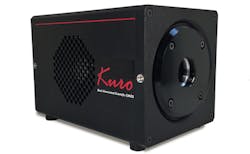Princeton Instruments introduces first back-illuminated scientific CMOS camera
Nov. 15, 2016
Princeton Instruments (Trenton, NJ) has introduced what it says is the world’s first scientific CMOS camera system to implement back-illuminated sensor technology. Back illumination had until now been almost exclusively in CCD camera systems, which despite their excellent sensitivity, can't match CMOS frame rates. Conventional front-illuminated CMOS cameras, meanwhile, can't meet the high-sensitivity requirements of ultralow-light scientific imaging and spectroscopy applications such as hyperspectral imaging, astronomy, cold-atom imaging, quantum imaging, fluorescence spectroscopy, and high-speed spectroscopy. Princeton Instruments says that its KURO:1200B back-illuminated camera has both the fast frame rates and the high sensitivity needed for modern scientific applications. Due to its back-illuminated scientific CMOS (sCMOS) sensor architecture, the new camera has greater than 95% quantum efficiency and 100% fill factor. The camera significantly reduces the fixed-pattern noise seen in front-illuminated sCMOS cameras and, due to the 100% fill factor, eliminates the need for microlenses. Microlens arrays are conventionally often used to boost light-collection efficiency when the fill factor is lower than 100%; however, these arrays have their own spectral absorption and limit the spectral range of the camera. The lack of microlenses lets the KURO detect light from the UV to the NIR without a reduction in quantum efficiency.95 dB dynamic range The camera has a read noise of 1.3 e- rms median, a frame rate of 82 fps at its full 1200 x 1200 resolution, and flexible off-chip (software) binning capabilities. Princeton Instruments says that the 11 μm2 pixel pitch of the detector captures 2.8 times more photons than other sCMOS sensors and handles a full well of 80,000 electrons, allowing a dynamic range of 61,500:1, or 95 dB. The KURO camera is designed to be used with the Princeton Instruments LightField software. The 64-bit LightField imaging and spectroscopy software has a built-in math engine to perform live data analysis, and allows direct control from third-party packages such as LabVIEW (National Instruments) and MATLAB (MathWorks). Input-output TTL signals are provided to allow synchronization of camera operation with external events or light sources. "Our new, back-illuminated sCMOS camera is tremendously well suited for use in non-gated, low-light-level applications with integration times of less than 10 seconds," says Ravi Guntupalli, vice president of sales and marketing at Princeton Instruments. For more info, see http://www.princetoninstruments.com/products/KURO-CMOS-cameras. Source: Princeton Instruments
Sponsored Recommendations
Sponsored Recommendations
March 31, 2025
March 31, 2025
March 31, 2025
Voice your opinion!
Voice your opinion!
